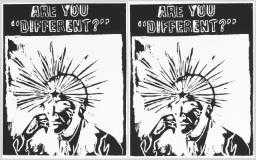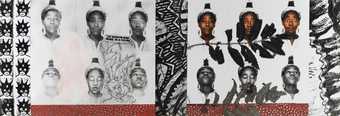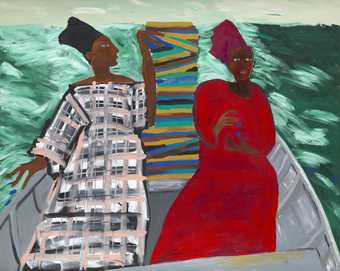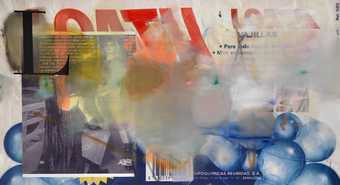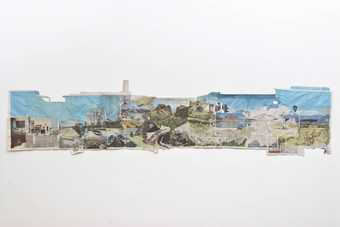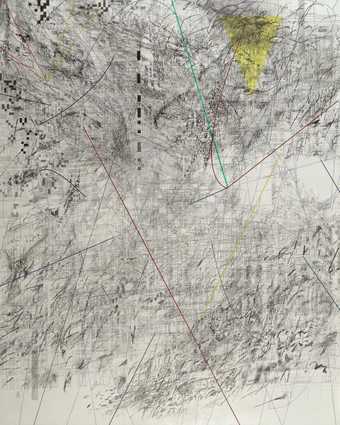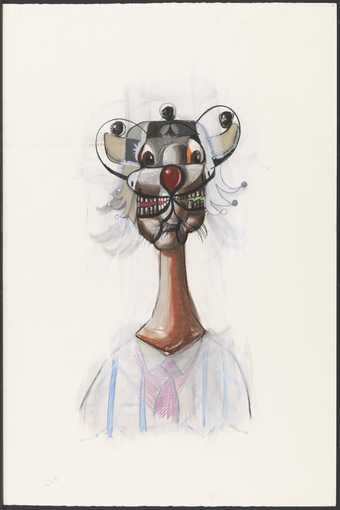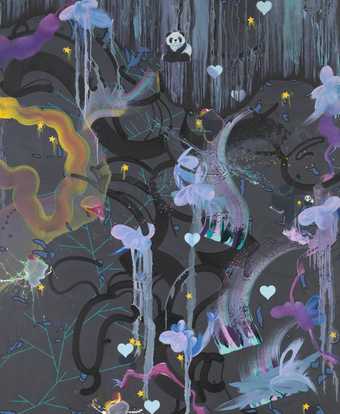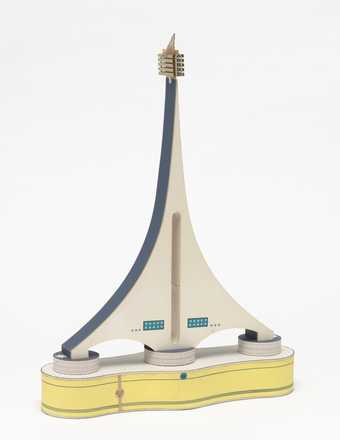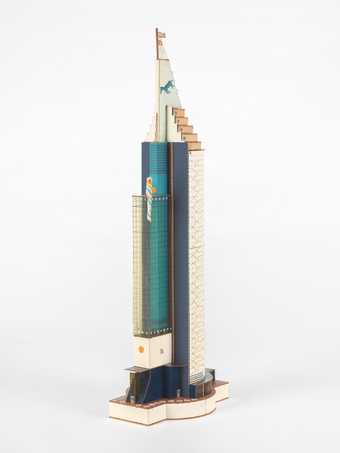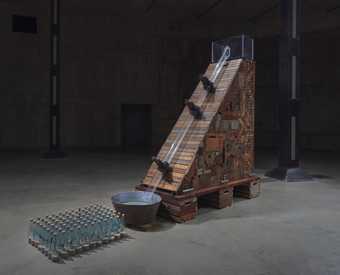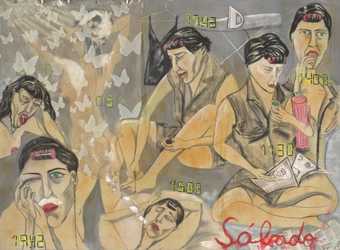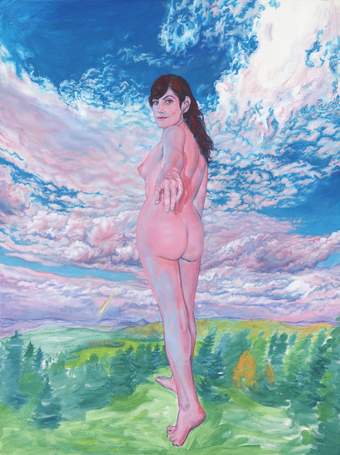
In Tate St Ives
- Artist
- Wangechi Mutu born 1972
- Medium
- Ink, acrylic paint, paint, crystalline particles, plastic pearls and paper on melinex
- Dimensions
- Support: 1300 × 825 mm
frame: 1418 × 935 × 47 mm - Collection
- Tate
- Acquisition
- Presented 2008
- Reference
- T12627
Summary
You were always on my mind 2007 is a large portrait-orientated painting with collage elements that depicts two heads, one positioned on the top of the other. Mounted onto a solid support, the painting is created on a thick sheet of tough, clear polyester film known as Melinex, the edges of which have been cut in gently undulating lines. The cloudy background is composed of a fine layer of white, black and grey acrylic paint that has been applied as a spray mist, with the outer edges much thicker and darker so that the central composition seems surrounded by light. Both heads are shown in profile from their right side, with their distinct outlines carefully drawn with ink and water. The lower and larger of the heads is mainly composed of pink and grey paint with the mottled colours running into one other to form a marbling effect. Several cut-out images on paper appear within this head, including a deep blue eye, a man dressed in Middle Eastern clothing and an animal skeleton. The figure’s neck is coated with red, green and gold glitter that is mixed together with an unevenly scattered series of small plastic beads of different sizes, while its arm (composed of plant and crustacean imagery) and hand (which reaches up to touch the chin) consist of further paper cut-outs. Protruding from the back of the lower head are thin strips of self-adhesive plastic featuring a wood-effect pattern that have been cut into twig shapes. The neck and large parts of the upper head are characterised by a moss-like surface of green, yellow and gold that is composed of acrylic paint, crystalline particles and glitter. The face of this upper head also incorporates paper cut-outs, including images of a fish, a section of orange coral and yellow flowers.
This work was made in 2007 in Brooklyn, New York, by the Kenyan artist Wangechi Mutu. As is typical of her paintings, You were always on my mind was created on a type of polyester film that the artist favours for its synthetic, non-absorbent qualities.
You were always on my mind was first displayed in Mutu’s debut UK solo exhibition held at the Victoria Miro Gallery, London, in 2007, which was titled Yo.n.I – a reference to the Sanskrit word yoni that can mean ‘divine passage’, ‘place of birth’ or ‘sacred temple’. Many of the paintings in the show integrated cut-out images of plants, flowers and animals – taken from natural history magazines and the internet – within their depictions of human forms, as part of a wider exploration of fertility and reproduction. The critic Ekow Eshun suggested in 2008 that the plant and animal imagery seen in this exhibition represented ‘a shift by the artist towards more sensuous matter’ (quoted in Mutu 2008, unpaginated). In an interview with Eshun in October 2007, Mutu explained the research that led to these works:
I was also drawn towards the lotus flower, female deities, fertility symbols from Ancient Egypt, Papua New Guinea, New Zealand, India, Kenyan warrior shields and headwear, Sheela na Gigs from Ireland [stone carvings of naked women], many, many histories and images, all of which held the sacred yoni very high.
(Mutu 2008, unpaginated.)
The title You were always on my mind seems to refer to the way in which the upper head in the composition appears to emerge from the mind of the figure beneath. Although the gender of these two figures remains ambiguous, several features, such as the eyelashes, lips and hand, are suggestive of female forms. In an interview with the critic Sarah Thornton published in 2014, Mutu claimed, ‘I am mostly, if not always, obsessed with images of women. As an African not living in my motherland, I’m also very sensitive to depictions of African people’ (quoted in Thornton 2014, p.56).
Mutu’s work, which has also included drawings, sculptures, videos, installations and performances, has frequently focused on the representation of the female body within a wide range of historical, political and cultural contexts. After studying anthropology and sociology, she completed a Masters in Fine Arts at Yale University in 2000. Her first group of collages on paper, compiled in the series Pin-Up 2001, featured images of badly injured women that were influenced by violence in Sierra Leone, while The Ark Collection 2006 consists of four vitrines displaying thirty-two altered postcards in which ethnographic pictures of African women are combined with pornographic images.
Mutu has emphasised the influence that the neo-expressionist paintings of the American artist Jean-Michel Basquiat (1960–1988) have had on her practice, stating that ‘When I discovered his work, I remember thinking, ah, that’s the way to attack these pristine problems’ (quoted in Thornton 2014, p.58). Like the colourful, composite figures in Basquiat’s paintings, the hybrid human forms Mutu has depicted in works such as You were always on my mind may be considered within the context of Afrofuturism – a term coined by the writer Mark Dery in 1994 that describes work across various disciplines that combines elements of science fiction and historical inquiry to imagine alternative visions of black people.
Further reading
Wangechi Mutu, Yo.n.I, exhibition catalogue, Victoria Miro Gallery, London 2008, reproduced no.14, unpaginated.
Tanya Barson and Peter Gorschlüter (eds.), Afro Modern: Journeys Through the Black Atlantic, exhibition catalogue, Tate Liverpool, Liverpool 2010, reproduced p.82.
Sarah Thornton, 33 Artists in 3 Acts, London 2014, pp.54–9.
Richard Martin
June 2015
Supported by Christie’s.
Does this text contain inaccurate information or language that you feel we should improve or change? We would like to hear from you.
Display caption
Mutu’s elaborate figurative paintings incorporate collaged materials from a variety of sources including medical journals, ethnographic photo-essays, fashion, wildlife and pornographic magazines. In this double profile, the larger, lower, head is mainly in earth tones, and includes collaged images of a begging figure and a jewelled hand. The smaller head is lushly coloured and partly built-up in layers of a moss-like plant substance. The entire construction suggests a conflation between natural and artificial constructions of beauty and plenty.
Gallery label, September 2008
Does this text contain inaccurate information or language that you feel we should improve or change? We would like to hear from you.
Explore
- abstraction(8,615)
-
- from recognisable sources(3,634)
-
- figure(2,270)
- formal qualities(12,454)
-
- fragmentation(233)
- photographic(4,673)
- clothing and personal items(5,879)
-
- jewellery(99)
- body(4,878)
-
- hair(437)
- head / face(2,497)
- health and welfare(696)
- satire(265)
You might like
-
Andy Warhol Are You Different?
c.1985–6 -
Lubaina Himid CBE RA Between the Two my Heart is Balanced
1991 -
Albert Oehlen Loa
2007 -
Tony Swain Jesus Help Me Find My Property
2007 -
Lubaina Himid CBE RA Ankledeep
1991 -
Lubaina Himid CBE RA Carpet
1992 -
Julie Mehretu Mogamma, A Painting in Four Parts: Part 3
2012 -
George Condo Outer Antipodes
1996 -
Fiona Rae Maybe you can live on the moon in the next century
2009 -
Bodys Isek Kingelez Untitled
2001 -
Bodys Isek Kingelez 155. Amango Bank
2001 -
Kemang Wa Lehulere I cut my skin to liberate the splinter: Act 1
2017 -
Marcia Schvartz Saturday
2004 -
Nash Glynn Self Portrait with One Foot Forward and One Hand Reaching Out
2020

